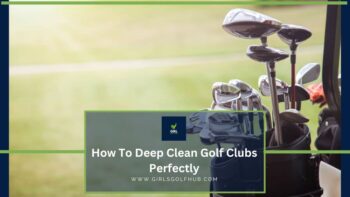The golf ball is The most important thing to playing the strikes and shots on the golf course! These special balls are really unique with their dimples and white colour, but they also hold a fascinating mystery within their seemingly simple exteriors. While holding a golf ball you must get a thought about “What is inside a golf ball & are golf balls hollow ”?
To cover this curiosity, I have researched and figured out many facts that a golfer should know about a golf ball. Because understanding the composition of golf balls and how it affects your performance might help explain how your respond on the course. Also, Let me tell you that, there are many secrets within these little but potent spheres as golfers swing their clubs and attempt to hit the perfect shot.
I have notified different golf balls like two or four-layer options in this post. To examine the manufacture of golf balls and examine their inner workings. So let’s find out the facts about golf ball technology and reveal the truth about their construction!
What A Golf Ball Has Inside Its Little Sphere – (The Anatomy)
Golf balls may seem like simple objects at first glance, but beneath their shiny white exterior lies a reasonable design to optimise their performance and playability. To cover the question Are Golf Balls Hollow, here are the key features that you should know first!
| 1. The Core | At the heart of every golf ball lies the core, a crucial component that significantly influences the ball’s performance characteristics. The core is responsible for dictating the ball’s compression, which affects its ability to transfer energy upon impact with the clubface. Golf ball cores are typically made of rubber materials, such as synthetic rubber or natural rubber, that offer varying levels of resilience and compression. |
| 2. The Shell | Surrounding the core is the golf ball’s shell or cover, which serves as the outermost layer of protection and aerodynamic design. The shell plays a pivotal role in the ball’s trajectory and spin control. There are two primary materials used for golf ball covers: Surlyn: Surlyn is a durable and resilient material commonly used in two-piece golf balls, which are favoured by amateurs and recreational players. This ionomer resin cover provides excellent distance and durability, making it a popular choice for golfers looking for long-lasting performance. Urethane: Urethane covers are found in premium golf balls, including three-piece and multi-layered designs preferred by professional players and low-handicap golfers. Urethane covers offer enhanced spin control, a softer feel, and improved greenside performance, allowing skilled players to shape shots with greater precision. |
| 3. Additional Layers (for Multi-layered Balls) | In more advanced golf ball designs, such as three-piece, four-piece, and five-piece balls, additional layers are strategically incorporated between the core and the cover. These layers serve specific purposes to optimize performance: Mantle Layer: Positioned between the core and cover, the mantle layer influences spin rates and overall ball behaviour. Different mantle materials and thicknesses can impart specific spin characteristics suited for various player preferences and shot types. Inner and Outer Layers: Multi-layered golf balls may have additional inner and outer layers, each contributing to the ball’s overall performance, including distance, spin, and feel. |
Also, learn about: Has Anyone Been Killed By A Golf Ball – Cases Threats & Saftey Measures
In golf, finding the right ball is like finding your perfect fit. Your skill level, preferences, and needs all matter. That is why getting familiar with the different types of golf balls is very important to discover your best choice to level up your performance on the course.
Types of Golf Balls – Their Characteristics & Advantages
To meet the varied demands and preferences of golfers, golf balls are made in a variety of designs and structures. Golfers can choose the ball that best suits their game by being informed about the features and benefits of each type of golf ball. So, here I have created a list to give you a frame of these different golf balls with multiple pieces!
| Characteristics: | Advantages: | |
| 1. One-Piece Golf Ball: |
Simple and basic design.Made of a single solid material, typically Surlyn.Often used in miniature golf or as practice balls. | Durable and long-lasting due to the solid construction.Cost-effective option for beginners and casual players.Suitable for recreational use and practice sessions. |
| 2. Two-Piece Golf Ball: |
Comprised of a solid rubber core and a durable cover (usually Surlyn or a softer urethane).One of the most popular designs among golfers of all skill levels. | Provides excellent distance due to the solid core’s ability to transfer energy efficiently.A durable cover allows for extended use without significant wear.Ideal for beginners and high-handicap players seeking distance and forgiveness. |
| 3. Three-Piece Golf Ball: | Features a complex construction with a solid rubber core, mantle layer, and cover.The mantle layer is positioned between the core and cover to influence spin rates. | Offers a balance between distance and control.Increased spin rates make it easier to stop the ball on the greens.Suitable for intermediate to advanced players seeking enhanced performance and shot shaping. |
| 4. Four-Piece Golf Ball: | Contains an additional layer compared to the three-piece design.Generally has a solid rubber core, dual mantle layers, and a cover. | Enhanced spin separation, allowing for more control on approach shots.Well-suited for players with faster swing speeds.Provides a softer feel and improved greenside performance. |
| 5. Five-Piece Golf Ball: |
The most complex and advanced design with multiple layers.Includes a solid rubber core, dual or triple mantle layers, and a soft urethane cover. | Offers the highest level of spin separation and control.Provides exceptional feel and responsiveness around the greens.Ideal for professional golfers and low-handicap players seeking maximum performance. |
You might be interested in: Learning About Golf Ball Size: Why Size Matter In The Greens
Remember! Your level in the game of golf evolves, showing the ideal match that fits your swing, style, and goals, just like the layers of a golf ball. Say yes to the challenges, decide your options, and choose the ball that helps you hit every goal along the course.
Let’s Cut Open Golf Balls To Know The Hollow
Curiosity often leads golfers to wonder what lies within the seemingly simple exterior of a golf ball. Cutting open a golf ball can offer a fascinating glimpse into its intricate construction. There are different methods to achieve this, and below, we’ll explore two popular approaches: the sharp method and the chop method.
1. The Sharp Cutting Procedure of Golf Balls:
Materials Needed:
- A sharp utility knife or a pocket knife
- Optional: rubber band for improved grip
Step-by-Step Instructions:
- Begin by choosing a thick golf ball for easier cutting. Dimpled golf balls may prove more challenging to cut open due to their uneven surface.
- Place the golf ball on a hard, stable surface with the seam facing upward. Ensure the ball lays flat for better control during cutting.
- Take the sharp utility knife or pocket knife and, if needed, wrap a rubber band around one end for a sturdier grip and more precise control.
- Slowly and carefully slice through the golf ball using an up-and-down motion, following the seam. Exercise caution during this process to avoid cutting yourself.
- As you cut, you may notice the blade slicing right through the ball if it’s sharp enough. Continue the cutting process to ensure a clean, even cut without any rough spots or jagged edges.
- If any rough edges remain, use the blade to smooth them out gently, taking care not to press too hard to avoid scratching the surface.
2. The Chop Cutting Procedure of Golf Balls
Materials Needed:
- A hammer or mallet
- A clear, open area like a patio or concrete driveway
Step-by-Step Instructions:
- Choose a thin golf ball for better results with the chop method. Thinner balls are more conducive to easy splitting.
- Find a safe, clear area free of any obstacles that could get damaged during the process.
- Hold the golf ball firmly in one hand or place it on a flat, stable surface, seam facing up.
- Aim the hammer or mallet directly at the seam of the golf ball.
- With a firm and swift blow, strike the golf ball at the seam, attempting to split it into two halves.
- Once you’ve succeeded in creating the initial split, hold one side of the ball and carefully pull it apart to reveal the interior layers.
“Be alert my golfer buddies! It’s true that cutting and opening the Golf Ball is really fun and I also cut my used ball usually. But here safety comes first, so you need to be careful with the Blade in Hand, to discover secrets that a golf ball has inside.”
Golf Balls With Liquid Core – Reviewing Past and Present
Golfers used to frequently choose liquid core balls, particularly three-piece ball designs. To improve playability, engineers employed liquid cores to regulate the amount of spin the ball produced. However, modifications to the core composition have been made as a result of technological and material innovations in golf balls over time.
The majority of modern golf ball cores are constructed from synthetic rubber, which provides reliable performance and resilience. Manufacturers frequently use additions like titanium or tungsten to improve particular qualities like compression and energy transmission. In order to attain the appropriate performance qualities, the core mixture will occasionally also contain the polymeric substance acrylate.
Although solid core designs and multi-layered constructions have mostly supplanted liquid core golf balls, liquid cores were formerly evaluated for their ability to control spin. Golf balls with increased distance, feel, and spin characteristics have been produced as a result of core material evolution, satisfying the needs of a variety of players and enhancing their performance on the course.
Golf Ball Regulations: Keeping the Game Fair and Balanced
Respect for the rules is the cornerstone of fair play and healthy competition in the world of golf. Golf balls must adhere to strict requirements laid out in Rule 5-1, which was developed by regulating bodies like the Royal and Ancient Golf Club of St. Andrews (R&A) and the United States Golf Association (USGA), to ensure a level playing field.
Golf balls are made with a solid rubber core that is precisely calibrated to obtain the best possible distance, especially when starting with a driver. According to USGA regulations, the core must weigh no more than 1.62 ounces (45.9 grams) and have a minimum diameter of 1.68 inches (42.7 mm). By following these rules, all golf balls used in competitive play will be uniform and fair.
The initial velocity of a golf ball when struck should not exceed 250 feet per second, with a strict tolerance of 2%, in order to preserve balance and prevent excessive advantages. This restriction keeps the competition on a level keel by preventing any player from gaining excessive distance off the tee.
A golf ball must also be spherically symmetrical with minimum variations in carry distance (no more than 4 yards) and flight time (no more than 0.4 seconds) in order for the game to maintain its integrity. These rules ensure that every player performs consistently by being applied regardless of the direction the ball spins as it is launched into the air.
ClosUp: An Explanation On Are Golf Balls Hollow
In my quest to uncover the mysteries of golf balls, I have covered the core components of these small yet powerful spheres. Through our exploration, we have learned that golf balls are solid, comprising a well-designed core and a durable dimpled shell. The core, made of solid rubber, influences compression, energy transfer, and overall distance. On the other hand, the cover, crafted from materials like Surlyn or urethane, impacts spin, feel, and control. Also, by understanding the construction and characteristics of different golf balls, we can make informed decisions when selecting the perfect fit for our game. From one-piece to multi-layered designs, each type of golf ball caters to various playing styles and skill levels. Check the best golf balls to get, Titleist Pro V1, TaylorMade TP5, Callaway Chrome Soft, Bridgestone Tour B RXS and Srixon Z-Star XV you can get the right fit for you by reviewing their specification.






